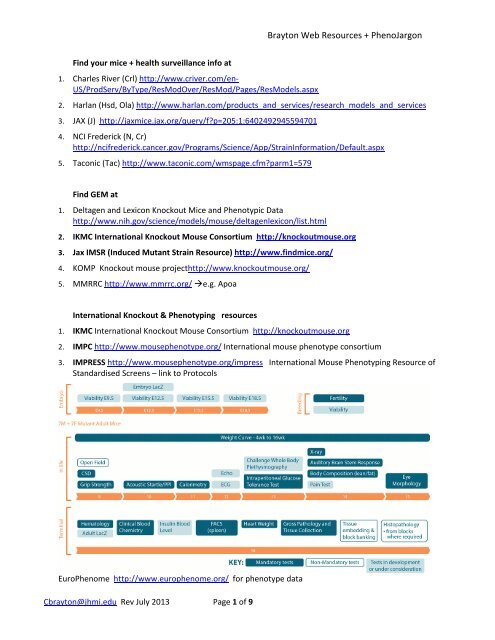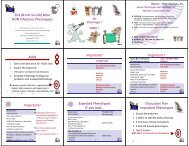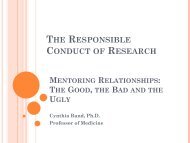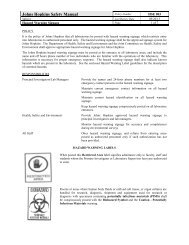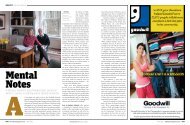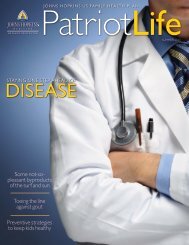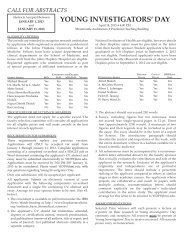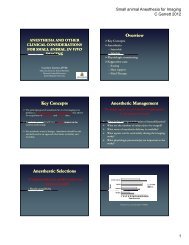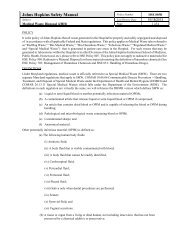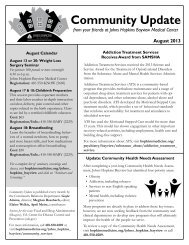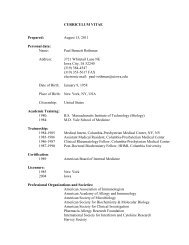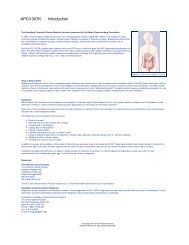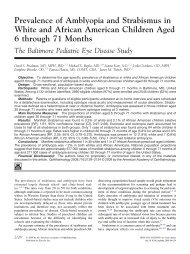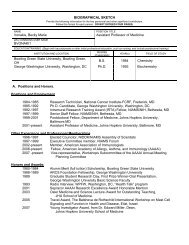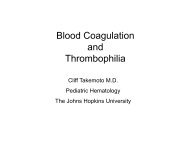Web Resources; Summary Tables, references (23 p PDF)
Web Resources; Summary Tables, references (23 p PDF)
Web Resources; Summary Tables, references (23 p PDF)
Create successful ePaper yourself
Turn your PDF publications into a flip-book with our unique Google optimized e-Paper software.
Brayton <strong>Web</strong> <strong>Resources</strong> + PhenoJargon<br />
Find your mice + health surveillance info at<br />
1. Charles River (Crl) http://www.criver.com/en‐<br />
US/ProdServ/ByType/ResModOver/ResMod/Pages/ResModels.aspx<br />
2. Harlan (Hsd, Ola) http://www.harlan.com/products_and_services/research_models_and_services<br />
3. JAX (J) http://jaxmice.jax.org/query/f?p=205:1:6402492945594701<br />
4. NCI Frederick (N, Cr)<br />
http://ncifrederick.cancer.gov/Programs/Science/App/StrainInformation/Default.aspx<br />
5. Taconic (Tac) http://www.taconic.com/wmspage.cfm?parm1=579<br />
Find GEM at<br />
1. Deltagen and Lexicon Knockout Mice and Phenotypic Data<br />
http://www.nih.gov/science/models/mouse/deltagenlexicon/list.html<br />
2. IKMC International Knockout Mouse Consortium http://knockoutmouse.org<br />
3. Jax IMSR (Induced Mutant Strain Resource) http://www.findmice.org/<br />
4. KOMP Knockout mouse projecthttp://www.knockoutmouse.org/<br />
5. MMRRC http://www.mmrrc.org/ e.g. Apoa<br />
International Knockout & Phenotyping resources<br />
1. IKMC International Knockout Mouse Consortium http://knockoutmouse.org<br />
2. IMPC http://www.mousephenotype.org/ International mouse phenotype consortium<br />
3. IMPRESS http://www.mousephenotype.org/impress International Mouse Phenotyping Resource of<br />
Standardised Screens – link to Protocols<br />
EuroPhenome http://www.europhenome.org/ for phenotype data<br />
Cbrayton@jhmi.edu Rev July 2013 Page 1 of 9
Brayton <strong>Web</strong> <strong>Resources</strong> + PhenoJargon<br />
More <strong>Resources</strong> on line<br />
1. Brain Atlas Projects<br />
High Resolution Mouse Brain Atlas http://www.hms.harvard.edu/research/brain/intro.html<br />
MBL (Mouse Brain Library) http://www.mbl.org/<br />
2. Complex Trait Consortium http://www.complextrait.org/ Collaborative Cross information<br />
3. Edinburgh Mouse Atlas Project (EMAP, EMAGE) http://www.emouseatlas.org/emap/home.html<br />
4. Jax online resources<br />
A Color Atlas of Neoplastic and Non Neoplastic Lesions in Aging Mice Frith & Ward 1988<br />
http://www.informatics.jax.org/frithbook/<br />
Anatomy of the laboratory mouse – Cook http://www.informatics.jax.org/cookbook/<br />
THE COAT COLOURS OF MICE (Silvers 1979) http://www.informatics.jax.org/wksilvers/<br />
IMSR – Find Mice ‐‐ http://www.findmice.org/index.jsp<br />
Jax – Es Cell list ftp://ftp.informatics.jax.org/pub/reports/ES_CellLine.rpt<br />
MGI http://www.informatics.jax.org/<br />
Michael Festings list & description of mouse strains<br />
http://www.informatics.jax.org/external/festing/rat/STRAINS.shtml<br />
Nomenclature home page http://phenome.jax.org/ LAB CODE<br />
MOUSE GENETICS by Lee Silver (Silver 1995) http://www.informatics.jax.org/silver/<br />
MPD http://phenome.jax.org/ (prioritized strains, protocols, data, more)<br />
MTB (Mouse Tumor Biology) Database http://tumor.informatics.jax.org/mtbwi/index.do<br />
Tumor frequency grid at http://tumor.informatics.jax.org/mtbwi/tumorFrequencyGrid.do<br />
Origins of inbred Mice – MORSE http://www.informatics.jax.org/morsebook/<br />
WELFARE AND REPORTING GUIDANCE<br />
1. ARRIVE GUIDELINES (Animals in Research: Reporting In Vivo Experiments)<br />
http://www.plosbiology.org/article/info%3Adoi%2F10.1371%2Fjournal.pbio.1000412<br />
Kilkenny, C., W. J. Browne, et al. (2010). "Improving bioscience research reporting: the ARRIVE guidelines for<br />
reporting animal research." PLoS Biol 8(6): e1000412.<br />
2. Workman, P., E. O. Aboagye, et al. (2010). "Guidelines for the welfare and use of animals in cancer<br />
research." Br J Cancer 102(11): 1555‐1577.<br />
http://www.nature.com/bjc/journal/v102/n11/full/6605642a.html<br />
3. 2011 (US) National Academy of Sciences (NAS) NAS Guidance for reporting animal research<br />
http://dels.nas.edu/Report/Guidance‐Description‐Animal/13241<br />
PATHOLOGY NOMENCLATURE – Terminology & Diagnostic Criteria<br />
1. MMHCC mouse models of human cancer consortium http://emice.nci.nih.gov/mouse_models/ <br />
consensus papers<br />
2. Pathbase European Mutant Mouse Pathology Database http://www.pathbase.net/<br />
3. RENI / INHAND http://www.toxpath.org/nomen/index.htm<br />
Toxpath RENI http://www.eurotoxpath.org/nomenclature/index.php trimming guidelines too<br />
Cbrayton@jhmi.edu Rev July 2013 Page 2 of 9
Brayton <strong>Web</strong> <strong>Resources</strong> + PhenoJargon<br />
MORE PATHOLOGY RESOURCES<br />
1. A Color Atlas of Neoplastic and Non Neoplastic Lesions in Aging Mice Frith & Ward 1988<br />
http://www.informatics.jax.org/frithbook/ + Print on Demand From http://store.cldavis.org/<br />
2. Aperio hosted digital slides corresponding to Treuting P, Dintzis S. Comparative Anatomy and Histology: A<br />
Mouse and Human Atlas London: Elsevier (Academic Press); 2012. http://repository.aperio.com/c/201/2/<br />
3. Cancer Images Database http://emice.nci.nih.gov/caimage<br />
4. Deltagen Mouse Histology Atlas<br />
5. JOVE (Charles River Laboratories)<br />
http://www.criver.com/en‐US/NewsEvents/WhatsNew/Pages/Gross_Examination_JoVE_Video.aspx<br />
http://www.criver.com/en‐US/NewsEvents/WhatsNew/Pages/Ecto_Endoparasites_JoVE_video.aspx<br />
6. MTB (Mouse Tumor Biology) Database http://tumor.informatics.jax.org/mtbwi/index.do<br />
Tumor frequency grid at http://tumor.informatics.jax.org/mtbwi/tumorFrequencyGrid.do<br />
7. NIAID Veterinary Pathology<br />
http://www.niaid.nih.gov/labsandresources/labs/aboutlabs/cmb/infectiousdiseasepathogenesissection/vet<br />
pathology/Pages/VeterinaryPathology.aspx<br />
8. NIEHS LEP Clinical Pathology<br />
9. NTP study results for control Data http://ntp.niehs.nih.gov/<br />
10. Skinbase mutant mouse skin pathology http://eulep.pdn.cam.ac.uk/~skinbase/index.php<br />
11. UC Davis MMHCC Image Archive<br />
12. UC Davis Visible Mouse<br />
13. UC Davis Virtual mouse Necropsy<br />
14. UC Davis Genomic Pathology Course Online http://ctrgenpath.net/main<br />
Cbrayton@jhmi.edu Rev July 2013 Page 3 of 9
Brayton <strong>Web</strong> <strong>Resources</strong> + PhenoJargon<br />
US based GEM & Phenotyping initiatives (since ~ 1998)<br />
MMRRC (Mutant Mouse regional resource centers) originally funded ~ 1998 by NIH NCRR to archive and<br />
distribute (not characterize) genetically engineered mouse stocks and ES cell lines ‐ ‘serving the world‐wide<br />
genetics and biomedical research community for the benefit of human health’ http://www.mmrrc.org/<br />
MMRRC at The Jackson Laboratory mmrrc@jax.org www.jax.org/mmrrc/<br />
MMRRC at Univ. of California, Davis mmrrc@ucdavis.edu mmrrc.compmed.ucdavis.edu<br />
MMRRC at Univ. of Missouri mmrrc@missouri.edu www.mmrrc.missouri.edu<br />
MMRRC at Univ. of North Carolina, Chapel Hill mmrrc@med.unc.edu<br />
MMHCC mouse models of human cancer consortium repository is based at NCI. 25 MMHCC Principal<br />
Investigators & research groups ivolved more than fifty institutions in the U.S. and abroad.<br />
http://emice.nci.nih.gov/ NIH funded ~2000‐2012<br />
Cancer Images Database http://emice.nci.nih.gov/caimage<br />
KOMP Knock Out Mouse Project Repository is a ‘trans‐NIH initiative to generate, together with the other<br />
members of the International Knockout Mouse Consortium (IKMC), a public resource of mouse embryonic stem<br />
(ES) cells containing a null mutation in every gene in the mouse genome ~2010‐2020<br />
Thus NIH participates in IKMC thru KOMP http://www.knockoutmouse.org/aboutkomp#komp‐network and<br />
began participation in high throughput IMPC phenotyping c2012 through KOMP2.<br />
http://commonfund.nih.gov/KOMP2/<br />
KOMP<br />
KOMP production Centers KOMP Data Coordination center KOMP repository<br />
1. CSD (CHORI, WTSI, UCDavis)<br />
2. Regeneron<br />
Jackson Laboratory<br />
UCDavis, CHORI<br />
http://www.komp.org/<br />
KOMP2<br />
Knockout Mouse Phenotyping<br />
(U54) RFA‐RM‐10‐011:<br />
1. UCD‐TCP‐CHORI consortium<br />
2. Jackson Laboratory<br />
3. BASH Consortium (Baylor<br />
Sanger Harwell)<br />
Knockout Mouse Phenotyping<br />
Project Database<br />
(U54) RFA‐RM‐10‐012:<br />
EMBL<br />
Knockout Mouse Production and<br />
Cryopreservation<br />
(U42) RFA‐RM‐10‐013:<br />
1. DTC consortium<br />
2. Jackson Laboratory<br />
3. BASH Consortium<br />
Cbrayton@jhmi.edu Rev July 2013 Page 4 of 9
EU and international GEM & Phenotyping initiatives (since ~ 2002)<br />
Brayton <strong>Web</strong> <strong>Resources</strong> + PhenoJargon<br />
EUMORPHIA was the initial EU initiative (2002‐2006) that created EMPRESS EUMODIC EUROPHENOME<br />
EUMODICs (European Mouse Disease Clinics) used EMPRESS (European Mouse Phenotyping Resource of<br />
Standardised Screens) Pipelines developed in the EUMORPHIA initiatives, but now (2013) use IMPC Pipelines –<br />
details at IMPRESS (International Mouse Phenotyping Resource of Standardised Screens).<br />
GEM & phenotype resources have proved to be highly bioinformatics dependent and driven, resulting in:<br />
CASIMIR (Coordination and Sustainability of International Mouse Informatics <strong>Resources</strong>) . Phenotype data from<br />
IMREPSS (formerly EMPRESS) pipelines feed into the EUroPhenome Database (also into MPD), using a<br />
standardized vocabulary /ontology<br />
MA = Mouse Anatomy ontology (the Anatomical Dictionary for the Adult Mouse,<br />
http://www.informatics.jax.org/searches/anatdict_form.shtml )., annotates tissue/entity) ,<br />
MP = Mammalian Phenotype ontology (http://www.informatics.jax.org/searches/MP_form.shtml<br />
(annotates normal/abnormal, present/absent, enlarged/small)<br />
MPATH annotates pathology process terms (e.g. necrosis), and diagnostic terms (e.g. carcinoma)<br />
PATO Phenotype and Trait Ontology (PATO) http://code.google.com/p/pato annotates<br />
distribution/size/shape/consistency/color/quantity)<br />
(Pathbase http://www.pathbase.net/ )<br />
EUCOMM is the European Conditional Mouse Mutagenesis Program which aims to generate archive &<br />
distribute up to 13.000 conditional mutations across the mouse genome in C57BL/6N ES cells<br />
Mutant ES cells & targeting vectors are distributed by European Mouse Mutant Cell Repository (EuMMCR)<br />
Mutant mice distributed by the European Mouse Mutant Archive (EMMA)<br />
‘coordinates’ with KOMP (&TIGM) in US & NorCoMM in Canada<br />
Infrafrontier is an EU initiative aiming to organize infrastructure networks for large‐scale phenotyping and<br />
archiving of mouse models serving the European genetics and biomedical research community. Infrafrontier<br />
builds on existing infrastructures from EMMA and EUMODIC to form a coalition with funding agencies to<br />
develop a common European infrastructure, Using 15 European laboratories.<br />
International Knockout Mouse Consortium (IKMC) http://www.knockoutmouse.org/ aims to mutate all<br />
protein‐coding genes in the mouse using a combination of gene trapping and gene targeting in C57BL/6 mouse<br />
embryonic stem (ES) cells. IKMC includes the following programs:<br />
1. Knockout Mouse Project (KOMP) (USA) (CSD, Regeneron; Jax)<br />
2. European Conditional Mouse Mutagenesis Program (EUCOMM) (Europe)<br />
3. North American Conditional Mouse Mutagenesis Project (NorCOMM) (Canada)<br />
4. Texas A&M Institute for Genomic Medicine (TIGM) (USA)<br />
International Mouse Phenotyping Consortium (IMPC) http://www.mousephenotype.org/ aims to provide<br />
systematic genome‐wide phenotyping of knockout mice generated from IKMC. As of 2013 there are 13<br />
participating sites in 10 countries<br />
Europe/UK North America AustralAsia<br />
1. DE, GMC Germany<br />
2. FR, ICS Strasbourg<br />
3. IT, CNR EMBL Monterotondo<br />
4. UK, MRC Harwell<br />
5. UK ,WTSI Sanger<br />
6. CA, TCP Toronto<br />
7. US, BASH Baylor, + Sanger, Harwell<br />
8. US, DTC ‐ UCDavis, CHORI, Charles<br />
River Laboratories + TCP<br />
9. US, Jackson Laboratories<br />
10. AU, APN<br />
11. CH, MARC<br />
12. JA, RIKEN<br />
13. KR, KMPC<br />
Cbrayton@jhmi.edu Rev July 2013 Page 5 of 9
Brayton <strong>Web</strong> <strong>Resources</strong> + PhenoJargon<br />
Jargonomics for Mouse Genomics ‐ Glossary for Mousers<br />
Location<br />
Acronym, term or part of Definition, URL, comments<br />
speech<br />
APN AU Australian Phenomics Network http://www.australianphenomics.org.au/<br />
BASH consortium INT 1 BaSH consortium, Baylor College of Medicine (BCM), Houston, Texas, the<br />
Wellcome Trust Sanger Institute Mouse Genetics Programme, Hinxton,<br />
United Kingdom, and the Medical Research Council Harwell, (Mammalian<br />
Genetics Unit and Mary Lyon Centre), United Kingdom, KOMP2 consortium<br />
for mouse production and cryopreservation and phenotyping<br />
http://commonfund.nih.gov/pdf/justice.pdf<br />
CASIMIR<br />
EU EC<br />
Coordination and Sustainability of International Mouse Informatics<br />
<strong>Resources</strong> http://www.casimir.org.uk/<br />
CARD<br />
JA<br />
Center for Animal <strong>Resources</strong> and Development<br />
http://card.medic.kumamoto‐u.ac.jp/card/english/index.html<br />
CHORI US Children's Hospital Oakland Research Institute<br />
CIBERDEM ES<br />
Centro de Investigación Biomédica en Red de Diabetes y Enfermedades<br />
Metabólicas Asociadas<br />
CMC CA Canadian Mouse Consortium http://www.mousecanada.ca/<br />
CMHD<br />
CA<br />
Centre for Modeling Human Disease at Toronto Centre for Phenogenomics<br />
(TCP) http://www.cmhd.ca/<br />
CMMR CA Canadian Mutant Mouse Repository http://www.cmmr.ca/<br />
Collaborative cross INT<br />
Panel of r multiparental recombinant inbred (RI) mouse lines derived from<br />
8 genetically diverse inbred strains—A/J, C57BL/6J, 129S1/SvlmJ,<br />
NOD/ShiLtJ, NZO/HlLtJ, CAST/EiJ, PWK/ Ph, and WSB/EiJ aiming to mode<br />
aiming to model complexity of the human genome<br />
http://compgen.unc.edu/wp/?page_id=99<br />
Collaborative team (KOMP awardee) at Children's Hospital Oakland<br />
CSD<br />
US Research Institute (CHORI), the Wellcome Trust Sanger Institute (WTSI) and<br />
UK the University of California at Davis (UCD) School of Veterinary Medicine ,<br />
more at http://www.knockoutmouse.org/about<br />
DTC consortium INT<br />
UC Davis, Toronto Centre for Phenogenomics (TCP), and Charles River<br />
Laboratories KOMP2 consortium for mouse production and<br />
cryopreservation http://www.komp.org/<br />
Dysmorphology noun<br />
First Pub med Citation 1966, D.W. Smith 102 author’s definition: The study of,<br />
or general subject of, abnormal development of tissue form; since used in<br />
reference to human (and more recently non human) teratology and<br />
malformations, abnormalities<br />
EMBL<br />
EU<br />
http://www.embl.it/index.php European Molecular Biology Laboratory –<br />
Grenoble Hamburg Heidelberg Hinxton Monterotondo<br />
EMBL Monterotondo is north of Rome, shared with Italian national research<br />
groups (IBC‐CNR) and the headquarters of the European Mouse Mutant<br />
Archive (EMMA).<br />
EMMA<br />
EU EC<br />
European Mouse Mutant Archive http://www.emmanet.org/<br />
See EMBL Monterotondo<br />
1 INT – international<br />
Cbrayton@jhmi.edu Rev July 2013 Page 6 of 9
Brayton <strong>Web</strong> <strong>Resources</strong> + PhenoJargon<br />
Acronym, term<br />
Location<br />
or part of Definition, URL, comments<br />
speech<br />
EMPRESS<br />
EU EC<br />
European Mouse Phenotyping Resource of Standardised Screens database<br />
of SOPs, from the EUMORPHIA consortium, ‐ NOW IMPRESS<br />
http://www.empress.har.mrc.ac.uk/<br />
EUCOMM EU EC<br />
European Conditional Mouse Mutagenesis project which (with KOMP &<br />
NorCOMM) aims to produce conditional mutations in 20,000 mouse genes,<br />
in C57BL/6N ES cells EUMODIC will use these ES cells in the null<br />
configuration http://www.eucomm.org/ consortium of 9 participants in 4 EU<br />
countries<br />
EUMODIC EU EC<br />
http://www.eumodic.org/ European MOuse DIsease Clinics assess mouse<br />
phenotypes using EMPReSS SOPs. Consortium of 18 laboratories in Europe.<br />
Eumorphia EU EC<br />
The initial EU functional genomics effort (2002‐2006) from which derive<br />
EMPRESS EUMODIC EUROPHENOME<br />
Europhenome EU EC<br />
http://www.europhenome.org/ database to hold phenome data obtained<br />
from EMPReSS now IMPRESS<br />
FIMRE INT Federation of International Mouse Researchers http://www.fimre.org/<br />
GEM, GMM, GMO<br />
Genetically Engineered Mice; Genetically Modified Mice; Genetically<br />
Modified Organisms<br />
GO<br />
Gene Ontology http://www.geneontology.org<br />
IEG<br />
FRG<br />
Institute for Experimental Genetics at Helmholz Munich – download<br />
MausDB LMIMS from http://jupiter.helmholtz‐muenchen.de/<br />
IGTC INT International Gene Trap Consortium http://www.genetrap.org/<br />
IKMC<br />
INT<br />
International Knockout Mouse Consortium (IKMC) aims to mutate all<br />
protein‐coding genes in mouse using gene trapping & targeting in C57BL/6<br />
ES cells: EUCoMM KOMP NorCoMM TIGM http://www.knockoutmouse.org/<br />
IMGS / IMGC INT<br />
International Mammalian (formerly Mouse) Genome Society – holds IMGC<br />
meetings; publishes Mammalian Genome, publishes mouse and gene<br />
nomenclature recommendations http://imgs.org/<br />
IMPC INT International mouse phenotype consortium<br />
http://www.mousephenotype.org/ I<br />
IMPRESS<br />
INT<br />
International Mouse Phenotyping Resource of Standardised Screens<br />
http://www.mousephenotype.org/impress link to Protocols<br />
INFRAFRONTIER EU UK CA<br />
Infrafrontier Project aims to establish research infrastructure for systemic<br />
phenotyping, archiving and distribution of mouse models, with partners in<br />
12 European countries and Canada http://www.infrafrontier.eu/<br />
INHAND<br />
INT<br />
International Harmonization of Nomenclature and Diagnostic Criteria for<br />
Lesions in Rats and Mice (INHAND) project<br />
(http://www.toxpath.org/nomen/)<br />
InterPhenome INT<br />
Integration of Mouse Phenome Data <strong>Resources</strong> / Mouse Phenotype<br />
Database Integration Consortium http://interphenome.org/<br />
IPGTT<br />
Intraperitoneal glucose tolerance test<br />
JMC JA Japan Mouse Clinic – see RIKEN<br />
Cbrayton@jhmi.edu Rev July 2013 Page 7 of 9
Brayton <strong>Web</strong> <strong>Resources</strong> + PhenoJargon<br />
Acronym, term<br />
Location<br />
or part of Definition, URL, comments<br />
speech<br />
KOMP<br />
US NIH<br />
Knock Out Mouse Project ‐ trans‐NIH initiative (2006‐2011) to generate, with<br />
the other members of the IKMC, a public resource of mouse embryonic stem<br />
(ES) cells containing a null mutation in every gene in the mouse genome.<br />
http://public.nhlbi.nih.gov/GeneticsGenomics/home/komp.aspx<br />
http://www.genome.gov/17515708<br />
http://www.komp.org/ KOMP repository at UCD<br />
KOMP2<br />
US NIH<br />
2010 NIH Common Fund program that aims to build on KOMP knockout<br />
mouse resource by initiatives to characterize (phenotype) IKMC mutant lines<br />
http://grants.nih.gov/grants/guide/rfa‐files/RFA‐RM‐10‐011.html<br />
http://commonfund.nih.gov/KOMP2/<br />
MARC<br />
CN<br />
Model Animal Research Center of Nanjing University, China<br />
Houses China’s National Resource for Mutant Mice (NRCMM)/<br />
http://www.en.nicemice.cn/<br />
MMHCC<br />
US NIH<br />
Mouse Models of human Cancer consortium, an initiative of NCI, more at<br />
http://emice.nci.nih.gov/<br />
MMRRC<br />
US NIH<br />
mutant mouse regional research resource centres supported by NCRR NIH<br />
http://www.mmrrc.org/<br />
MGI<br />
US JAX NIH<br />
Mouse Genome Informatics – LOOK UP GENES NOMENCLATURE<br />
HOMOLOGIES ALLELES REFRENCES http://www.informatics.jax.org/<br />
MGP UK See WTSI MGP Wellcome Trust Sanger Institute Mouse Genetics Programme<br />
MODIS<br />
US<br />
Mouse Disease Information System (MoDIS) database tools for recording<br />
mouse pathology diagnoses/phenotypes<br />
http://research.jax.org/faculty/sundberg/index.html<br />
MRB EU GR Mouse Resource Browser http://bioit.fleming.gr/mrb/<br />
MPD US JAX NIH MOUSE PHENOME DATABASE 2 http://phenome.jax.org/<br />
MUGEN MMDB EU GR<br />
MUGEN Mouse Database (MMdb) of murine models of immune processes<br />
and immunological diseases, developed by MUGEN consortium of 21<br />
institutes and universities http://bioit.fleming.gr/mugen/mde.jsp<br />
Muromics Noun The science and study of mice; first pub med citation 2002 S.W. Barthold 33<br />
MTB<br />
US JAX NIH<br />
Mouse Tumor Biology Database<br />
http://www.informatics.jax.org/mtbwi/index.do<br />
MMPC US NIH Mouse Metabolic Phenotyping Consortium http://www.mmpc.org/<br />
NorIMM EU Nordic Infrastructure for Mouse Models<br />
NFGN FRG Nationales Genomforschungsnetz Deutschland<br />
Pathbase UK European mutant mouse pathology database http://eulep.pdn.cam.ac.uk/<br />
PATO<br />
PRIME<br />
Phenobabelomics<br />
Phenogenomics<br />
EU EC<br />
Noun<br />
Noun<br />
Phenotype and Trait Ontology http://code.google.com/p/pato<br />
Priorities for Mouse Functional Genomic Research across Europe.<br />
http://www.prime‐eu.org/<br />
First pub med citation 2008, J Hancock and A‐M. Mallon 66 in reference to<br />
phenotyping terms and the challenge for bioinformatics<br />
Science or study of the relationships between phenome and genome of an<br />
organism; frst pub med citation, 2001 J Rossant and C McKerlie 104<br />
Cbrayton@jhmi.edu Rev July 2013 Page 8 of 9
Brayton <strong>Web</strong> <strong>Resources</strong> + PhenoJargon<br />
Acronym, term<br />
Location<br />
or part of Definition, URL, comments<br />
speech<br />
Phenome<br />
Noun<br />
Originally: the sum total of the constituents of a cell exclusive of its genetic<br />
material (rare). Now more widely: the phenotypic counterpart or expression<br />
of the genome; the complete set of phenotypic characteristics of an<br />
organism. From Oxford English dictionary at http://www.oed.com/ accessed<br />
8/<strong>23</strong>/2010 Attributed to 1964 Soulé Systematic Zool. 113 114/2 … phenome<br />
(the phenotypic analog of the genome)<br />
Phenotype Noun<br />
The sum total of the observable characteristics of an individual, regarded as<br />
the consequence of the interaction of the individual's genotype with the<br />
environment; a variety of an organism distinguished by observable<br />
characteristics rather than underlying genetic features. From Oxford English<br />
dictionary at http://www.oed.com/ accessed 8/<strong>23</strong>/2010. Attributed to W.<br />
Johannsen c 1910.<br />
Phenotype Verb<br />
To allocate to a phenotype. From Oxford English dictionary at<br />
http://www.oed.com/ accessed 8/<strong>23</strong>/2010. Attributed to W. Johannsen c<br />
1910.<br />
RENI<br />
Registry Nomenclature Information System<br />
http://www.goreni.org/<br />
RIKEN (RBRC) JA<br />
Riken Bioresource Center http://www.brc.riken.jp/lab/animal/en/<br />
Houses Japan Mouse Clinic JMC<br />
http://www.brc.riken.jp/lab/jmc/mouse_clinic/en/<br />
SHIRPA<br />
UK<br />
Qualitative morphological, clinical behavioral screening method for<br />
abnormal phenotypes in the mouse – Acronym for<br />
SmithKline Beecham Pharmaceuticals<br />
Harwell, MRC Mouse Genome Centre and Mammalian Genetics Unit<br />
Imperial College School of Medicine at St Mary's<br />
Royal London Hospital, St Bartholomew's and the Royal London School of<br />
Medicine<br />
Phenotype<br />
Assessment<br />
SweIMP EU Swedish Infrastructure for Mouse Phenotyping<br />
TIGM US Texas Institute for Genomic Medicine http://tigm.org/ participant in IKMC<br />
UCD‐TCP‐CHORI<br />
consortium<br />
WTSI MGP<br />
UK<br />
Mouse Biology Program at U. California Davis (UCD), the Toronto Center for<br />
Phenogenomics (TCP), and Children's Hospital of Oakland Research<br />
Institution (CHORI). A KOMP2 phenotyping consortium<br />
http://www.komp.org/<br />
Wellcome Trust Sanger Institute Mouse Genetics Program<br />
http://www.sanger.ac.uk/mouseportal/<br />
Cbrayton@jhmi.edu Rev July 2013 Page 9 of 9
Mouse Diseases Common Conditions (phenotypes) and Infectious Diseases TABLES only<br />
TABLES ‐ Table number corresponds to section in TEXT<br />
Table Ia Common conditions by age Page 2<br />
Table Ib Common conditions or phenotypes by strain<br />
Table Ic Some immune relevant genotypes (in common strains)<br />
Table Id Immunodeficient mice: Properties of important genes & mutations Page 5<br />
Table Ie Immunodeficient mice: Effects of Background strain on phenotypes<br />
Table If Immunodeficient mice: Primary T cell deficient options<br />
Table Ig Immunodeficient mice: MORE nude options<br />
Table Ih Immunodeficient mice: MORE scid options<br />
Table Ii Immunodeficient mice: MORE options<br />
Table II Infectious Agents by site/system Page 9<br />
Table IV Viruses – Test methods, prevalence<br />
Table V Bacteria – Test methods, prevalence<br />
Table VI Eukaryotes – Test methods, prevalence<br />
Table VIa Protozoa by site<br />
Table VIb Fur mite comparison<br />
Table VIc Pinworm comparison<br />
WEB <strong>Resources</strong> Page 14<br />
References<br />
I<br />
II<br />
III<br />
IV<br />
V<br />
VI<br />
TEXT SECTIONS see also [1]<br />
Common disease conditions – Spontaneous or Non infectious<br />
Common diseases – Infectious by system<br />
Infectious agents, diagnostic methods<br />
Infectious agents, Viruses<br />
1. Comments by agent (alphabetical order)<br />
Infectious agents, Bacteria<br />
1. Comments by agent (alphabetical order)<br />
Infectious agents, Eukaryotes<br />
1. Fungi – inc Protista – Comments by agent (alphabetical order)<br />
2. Protozoa – Comments by agent (alphabetical order)<br />
Metazoa ‐ Comments by agent (alphabetical order)<br />
a) Arthropods Comments by agent (alphabetical order)<br />
b) Helminths Comments by agent (alphabetical order)<br />
cbrayton@jhmi.edu 2013 Page 1 of 14
Mouse Diseases Common Conditions (phenotypes) and Infectious Diseases TABLES only<br />
Table Ia: Non infectious CLINICAL conditions in mice at different ages [2] [3] [4]<br />
Life threatening<br />
Usually not life<br />
threatening<br />
Usually young mice<br />
Hydrocephalus<br />
Malocclusion<br />
Microphthalmia<br />
Usually adult,<br />
various ages<br />
Dermatitis and wounds<br />
Abdominal enlargement (e.g.<br />
hydrometra,<br />
hydronephrosis, urinary<br />
obstruction, ascites).<br />
‘Neurologic’ signs (e.g. paresisparalysis,<br />
seizures, vestibular<br />
signs)<br />
Alopecia due to barbering<br />
Blind / deaf<br />
Usually older mice<br />
Neoplasia (tumors)<br />
Wasting due to chronic<br />
progressive<br />
conditions (e.g.<br />
amyloidosis,<br />
nephropathy,<br />
neoplasia)<br />
Obesity<br />
Table Ib. Non infectious conditions and neoplasms in common mouse strains [2] [3] [4] [5]<br />
129 strains Acallosity‐hypocallosity; acidophilic macrophage pneumonia, hyalinosis<br />
Lung tumors (testicular teratomas)<br />
A/J<br />
Congenital anomalies; amyloidosis; muscular dystrophy<br />
Lung tumors, rhabdomyosarcoma [6]<br />
AKR<br />
Thymic lymphoma<br />
BALB/c<br />
BALB/cBy<br />
C3H<br />
C57BL/6<br />
DBA<br />
FVB/N<br />
NOD<br />
SJL/J<br />
Swiss<br />
Not inbred<br />
BLIND rd1<br />
DEAF<br />
Acallosity‐hypocallosity; conspecific (male) aggression; cardiac calcinosis; cardiac thrombi;<br />
vaginal septa<br />
Lung tumors; Harderian gland tumors; myoepithelioma; rhabdomyosarcoma,<br />
induced plasmacytoma<br />
Blind (rd1/rd1); cardiac calcinosis, soft tissue mineralization<br />
Mammary tumors in females; liver tumors in males<br />
Hydrocephalus; microphthalmia; ulcerative dermatitis; amyloidosis; acidophilic macrophage<br />
pneumonia, hyalinosis<br />
Lymphoma; histiocytic sarcoma<br />
dba, Cardiac calcinosis, soft tissue mineralization; seizures; deafness; glaucoma<br />
Blind (rd1/rd1); seizures; mammary hyperplasia<br />
Lung tumors<br />
Diabetes; immune alterations<br />
Lymphoma<br />
Blind (rd1/rd1); conspecific (male) aggression; muscular dystrophy<br />
Radioresistant<br />
Lymphoma<br />
Strain stock variations in: blind due to rd1/rd1; acidophilic macrophage pneumonia;<br />
amyloidosis; nephropathy; urinary syndrome<br />
Lymphomas; lung tumors; liver tumors; skin tumors<br />
C3H, CBA, FVB, SJL, SWR etc<br />
C57BL/6, BALB, DBA, etc<br />
Re tumor frequency – see also http://tumor.informatics.jax.org/mtbwi/index.do<br />
cbrayton@jhmi.edu 2013 Page 2 of 14
Mouse Diseases Common Conditions (phenotypes) and Infectious Diseases TABLES only<br />
Table Ic: Some immune relevant genotype variations (in common strains) [7]<br />
Gene Gene /Locus name Chrom Allele Allele name Mutation Strains<br />
symbol<br />
Symbol<br />
H2<br />
Major<br />
17 a H2a * A (A/HeJ, A/J, AWySnJ)<br />
Histocompatibility<br />
Complex (MHC) H2<br />
haplotypes<br />
H2 MHC H2 haplotype 17 b H2b C57BL/6, C57BL/10<br />
129 ‐ all?<br />
H2 MHC H2 haplotype 17 b2 H2b2 NZB<br />
H2 MHC H2 haplotype 17 d H2d DBA/2<br />
BALB/c, BALB/cBy,<br />
H2 MHC H2 haplotype 17 g7 H2g7 NOD<br />
H2 MHC H2 haplotype 17 k H2k AKR,<br />
C3H, CBA, MRL<br />
H2 MHC H2 haplotype 17 P H2p P<br />
H2 MHC H2 haplotype 17 q H2q DBA/1, FVB/N, Nu/J<br />
H2 MHC H2 haplotype 17 r H2r RIII<br />
H2 MHC H2 haplotype 17 s, s2 H2s,s2 SJL, SJL/J<br />
H2 MHC H2 haplotype 17 z H2z NZW, NZN, NZO<br />
Hc<br />
Hemolytic<br />
complement (c5)<br />
2 0<br />
(Hc 0 )<br />
Tlr4 Toll like receptor 4 4 Lps‐d<br />
(Tlr4 Lsp‐d )<br />
Rmcf MCF sensitive 5 s<br />
(Rmcf s )<br />
Rmcf MCF sensitive 5 R<br />
(Rmcf r )<br />
Ceacam1 carcinoembryonic 7 Hc2‐r<br />
antigen‐related cell<br />
(Ceacam1<br />
adhesion molecule<br />
Hv2‐r )<br />
1<br />
Klra1<br />
(Ly49a)<br />
killer cell lectin‐like<br />
receptor, subfamily<br />
A1 (aka Ly49A)<br />
6 Klra1<br />
C57BL/6<br />
etc<br />
Klra2 Aka Ly49B 6 Klra2<br />
C57BL/6<br />
etc<br />
Klra3 Aka Ly49C 6 Klra3<br />
C57BL/6<br />
Klra5,6,9,1<br />
5,17,19,<br />
20,21,22<br />
Aka Ly49E,F,I,O,<br />
Q,S,T,V<br />
0 = deficient 2 base "TA"<br />
deletion<br />
d = defective<br />
lipopolysaccharide<br />
response<br />
s = sensitive to mcf<br />
forming leukemia viruses<br />
C to A<br />
substitution<br />
in 3 rd exon<br />
recessive<br />
A/HeJ, AKR/J, DBA/2J,<br />
FVB/N; NZB/B1NJ,<br />
SWR/J, B10.D2/SnJ<br />
C3H/HeJ<br />
AKR/J, C57BL/6,<br />
BALB/c, CBA/J, NFS,<br />
NZB, 129/J.<br />
DBA/1, DBA/2, and<br />
CBA/Ca<br />
SJL/J<br />
Resistant to mcf forming<br />
leukemia viruses<br />
Dominant<br />
allele<br />
r = resistance to Mouse Deletion <br />
hepatitis virus (MHV‐4) <strong>23</strong> aa<br />
substitution<br />
recessive<br />
Inhibit killing activity [8] Various B6, NOD, 129, BALB/c<br />
Inhibit killing activity [8] Various B6, 129, BALB/c<br />
Inhibit killing activity [8] Various B6, NOD, BALB/c<br />
etc<br />
6 Inhibit killing activity [8] Various Various<br />
* See also http://jaxmice.jax.org/literature/catalog/mhc_h2_haplotypes.pdf<br />
http://www.imgt.org/IMGTrepertoireMHC/Polymorphism/haplotypes/mouse/MHC/Mu_haplotypes.html<br />
cbrayton@jhmi.edu 2013 Page 3 of 14
Mouse Diseases Common Conditions (phenotypes) and Infectious Diseases TABLES only<br />
Gene<br />
symbol<br />
Klra4,8,<br />
13,14,16,<br />
18,21,<strong>23</strong>,<br />
25,28,30<br />
Mx1<br />
Mx1<br />
Mx1<br />
Tcrb‐V8<br />
Tcrb‐V8<br />
Nlrp1a<br />
Nlrp1a<br />
Slc11a1<br />
(Nramp1)<br />
Slc11a1<br />
(Nramp1)<br />
Gene /Locus name Chrom Allele<br />
Symbol<br />
Allele name Mutation Strains<br />
Aka Ly4D,H,M, 6 Activate NK etc [8] Various Various<br />
N,P,R,U,W<br />
myxovirus<br />
(influenza virus)<br />
resistance 1<br />
myxovirus<br />
resistance 1<br />
myxovirus<br />
resistance 1<br />
T cell receptor beta,<br />
variable 8<br />
T cell receptor beta,<br />
variable 8<br />
NOD‐like receptor<br />
(NLR) 1a<br />
NOD‐like receptor<br />
(NLRs) 1a<br />
solute carrier family<br />
11 member 1; host<br />
resistance<br />
solute carrier family<br />
11 member 1;<br />
pathogen<br />
susceptibility<br />
16 Mx1 r r = resistance to<br />
Myxovirus (etc<br />
intranuclear virus ) [9]<br />
Wild type A2G, SL/NiA, CAST/Ei<br />
16 Mx1 s1 s1 = susceptibility 1 [10] deletion Most common strains<br />
C57BL/6J, C3H/HeJ,<br />
BALB/cJ,etc<br />
16 Mx1 s2 s2 = susceptibility 2 [10] Point CBA/J, CE/J, I/LnJ,<br />
mutation<br />
PERA/Ei<br />
6 Tcrb‐V8 a A = wild type Wild type A/J, AKR/J, BALB/cJ,<br />
C3H/HeJ, C57BL/10J,<br />
C57BL/6J, MRL<br />
6 Tcrb‐V8 c deletion C57L/J, SJL/J<br />
11 Nlrp1a R/R Resistance to anthrax LT<br />
lethal toxin [11] NLRs =<br />
inflammasome<br />
components<br />
11 Nlrp1a s/s Sensitivity to anthrax LT<br />
lethal toxin [11]<br />
1 Slc11a1 r r = resistance to certain<br />
agents – some<br />
Mycobacterium sp,<br />
S. typhimurium,<br />
L donovani [12]<br />
1 Slc11a1 s s = susceptibility to<br />
certain agents – some<br />
Mycobacterium sp,<br />
S. typhimurium,<br />
L donovani [12]<br />
dominant<br />
allele<br />
(wild type?)<br />
G to A<br />
point<br />
mutation<br />
recessive<br />
C57BL/6J, A/J, I/LnJ,<br />
SPRET/EiJ, PWK/PhJ,<br />
PWD/PhJ, AKR/J,<br />
NOD/LtJ, DBA/2J<br />
129S1/SvlmJ, Balb/cJ,<br />
FVB/NJ, SWR/J,<br />
CAST/EiJ, C57/LJ<br />
A; C3H; CBA; DBA [12]<br />
C3H/HeJ, 129/Sv<br />
BALB/c; C57BL [12]<br />
Search for gene/locus/allele updates at http://www.informatics.jax.org/<br />
Search for mice at http://www.findmice.org/index.jsp<br />
cbrayton@jhmi.edu 2013 Page 4 of 14
Mouse Diseases Common Conditions (phenotypes) and Infectious Diseases TABLES only<br />
Table Id: Immunodeficient mice: properties of important genes & mutations<br />
Gene<br />
B2m<br />
beta‐2<br />
microglobulin<br />
Foxn1<br />
forkhead box N1,<br />
formerly Hfh11<br />
Il2rg<br />
interleukin 2<br />
receptor, gamma<br />
chain<br />
Myd88<br />
myeloid<br />
differentiation<br />
primary response<br />
gene 88<br />
Prf1<br />
perforin 1<br />
(pore‐forming<br />
protein)<br />
Prkdc<br />
protein kinase,<br />
DNA‐activated,<br />
catalytic<br />
polypeptide<br />
Rag1<br />
recombination<br />
activating gene 1<br />
Ticam1<br />
Trif<br />
PROPERTIES<br />
Required for normal expression of major histocompatibility class I proteins (displaying viral and self<br />
antigens to potentially responsive T cells) and for<br />
CD8+ T cell maturation and NK cell development<br />
Tm Deficiency NK cell development/activity, CD8+ T cell activity<br />
nu mutation known as nude.<br />
nu/nu are ‘hypothymic’ – ‘athymic’ T cell deficient; respond poorly to thymus‐dependent antigens,<br />
should accept allogeneic and xenogeneic grafts(but may have NK activity & be leaky)<br />
Greatly increased susceptibility to infection.<br />
Necessary for IL2, IL4, IL7, IL9, IL15, IL21 high affinity binding & signaling.<br />
Role in mediating susceptibility to thymic lymphomas in mice<br />
Tm Deficiency NO NK development +other defects in innate immunity.<br />
NO thymic lymphomas on susceptible background<br />
Myd88 is an adapter protein used by all TLRs (except TLR 3) to activate transcription factor NF-κB in<br />
innate immunity<br />
Tm Deficiency innate responses – neutrophils, macrophages,<br />
hematopoietic, molecular signaling, and apoptotic abnormalities<br />
Essential in lytic pathway by which NK and CD8+ lymphocytes kill targeted cells.<br />
Tm Deficiency NK cell activity, CD8+ T cell activity<br />
Involved in repairing double‐stranded DNA breaks and in recombining the variable (V), diversity (D), and<br />
joining (J) segments of immunoglobulin and T‐cell receptor genes.<br />
scid mutation/allele ‘severe combined immunodeficient’<br />
scid/scid no mature T and B cells, cannot mount cell mediated or humoral adaptive immune<br />
responses, do not reject allogeneic and xenogeneic grafts, useful cancer research models.<br />
BUT leakiness some functional B and T cells as they age.<br />
leakiness in non‐SPF conditions,<br />
leakiness C57BL/6J, BALB/cByJ backgrounds > C3H/HeSnJSmn > NOD/LtSzJ background<br />
++ radiosensitive cannot be as thoroughly irradiated as other immunodeficient models before<br />
being engrafted<br />
renders NOD mice diabetes‐free useful for adoptive transfer of diabetes by T cells.<br />
Essential for V(D)J gene rearrangements necessary functional antigen receptors in T & B cells.<br />
Deficient tm1Mom mutants no mature, functional T and B cells.<br />
Renders NOD mice diabetes‐free.<br />
+ B cell lymphomas in NOD.129S7(B6)‐Rag1tm1Mom/J<br />
Toll-like receptor adaptor molecule 1 (formerly uses TIR-domain–containing adapter-inducing interferon-b<br />
(TRIF)). adapter protein used by TLR 3 to activate transcription factor NF-κB in innate immunity<br />
Tm Deficiency innate responses – esp when combined with Myd88 Tm<br />
Tm = targeted mutation (knockout)<br />
cbrayton@jhmi.edu 2013 Page 5 of 14
Mouse Diseases Common Conditions (phenotypes) and Infectious Diseases TABLES only<br />
Table Ie: Immunodeficient mice: Effects of Background strain on phenotypes<br />
adapted from Jaxnotes #501, 2006 [13] http://jaxmice.jax.org/jaxnotes/archive/501.pdf etc<br />
Back ground<br />
BALB<br />
Substrains<br />
C57BL/6J<br />
Innate<br />
NK etc<br />
Leaky H2 Examples<br />
‘common name’<br />
Normal Yes T d CByJ.Cg‐Foxn1 nu /J<br />
‘BALB/c Nude’<br />
Normal High d CBySmn.CB17‐<br />
Prkdc scid /J<br />
‘BALB/c scid’<br />
Normal<br />
<br />
Normal<br />
<br />
NO b B6.129S7‐<br />
Rag1 tm1Mom /J<br />
‘B6 Rag’<br />
High b B6.CB17‐<br />
Prkdc scid /SzJ<br />
‘B6 scid’<br />
NOD Low NO g7 NOD/ShiLtJ<br />
‘NOD’<br />
Low NO g7 NOD.129S7(B6)‐<br />
Rag1 tm1Mom /J<br />
‘NOD Rag’<br />
Low NO g7 NOD.Cg‐Rag1 tm1Mom<br />
Prf1 tm1Sdz /SzJ<br />
‘NOD Rag Prf’<br />
Low Low g7 NOD.CB17‐<br />
Prkdc scid /J<br />
Low Low g7 NOD.Cg‐Prkdc scid<br />
B2m tm1Unc /J<br />
‘NOD scid B2m’<br />
Low NO g7 NOD.Cg‐Prkdc scid<br />
Il2rg tm1Wjl /SzJ<br />
‘NSG’<br />
Low NO NOD.Cg‐Prkdc scid<br />
Il2rg tm1Sug /JicTac<br />
‘NOG’<br />
Characteristics (Phenotypes)<br />
Normal B cells etc<br />
Extra thymic T cells with age<br />
POOR breeders, female fertility nu/+ F x nu/nu M<br />
NO functional B and T cells<br />
HIGH NK, complement activity (normal APC function)<br />
Thymic lymphomas but < NOD.CB17‐Prkdcscid/SzJ<br />
RadioSensitive<br />
NO functional B and T cells<br />
HIGH NK activity (normal APC, complement c5)<br />
NO functional B and T cells<br />
HIGH NK, complement activity (normal APC function)<br />
susceptible to immune mediated insulitis + diabetes<br />
NK, macrophage, APC activity; Hc 0 No c5<br />
RadioResistant<br />
NO functional B and T cells<br />
Pre‐B cell > Thymic lymphomas ( 10.5mo)<br />
Somewhat RadioResistant<br />
NO functional B and T cells,<br />
NO NK cell activity; Hc 0 No c5<br />
Thymic lymphomas (short lifespan ~8.5mo)<br />
RadioResistant: survives up to 8 Gy<br />
NO functional B and T cells<br />
NOD background low NK activity, Hc 0 No c5,<br />
defects in myeloid development, poor APC functions<br />
Thymic lymphomas (short lifespan ~8.5mo)<br />
RadioSensitive: tolerates up to 4 Gy<br />
NO functional B and T cells<br />
No MHC 1 expression ~NO NK activity<br />
Thymic lymphomas (short lifespan ~6.3mo)<br />
Hemochromatosis dt?<br />
NO lymphocytes; NO NK cell activity<br />
Lymphoma‐resistant; long‐lived > 16m<br />
JAX<br />
NO lymphoctes; NO NK cell activity<br />
Lymphoma‐resistant; long‐lived > 16m<br />
TAC<br />
NIH stock Normal Yes T q NU/J (Foxn1nu) NIH outbred nude stock inbred at TJL<br />
cbrayton@jhmi.edu 2013 Page 6 of 14
Mouse Diseases Common Conditions (phenotypes) and Infectious Diseases TABLES only<br />
Table If: Immunodeficient mice: Primary T cell deficient options<br />
Mutations<br />
T<br />
Cells<br />
B<br />
Cells<br />
Innate<br />
NK<br />
Leaky<br />
Tumors<br />
Foxn1 nu (nude) D N N yes<br />
Prkdc scid (scid) D D N‐ yes<br />
Prkdc scid Lyst bg<br />
(scid‐bg)<br />
NOD‐Prkdc scid<br />
(NOD‐scid)<br />
NOD, Prkdc scid ,<br />
Il2rg tm… (NSG, NOG)<br />
D = Deficient, N = ‘normal’<br />
D D N<br />
Reduced by<br />
bg<br />
D D D Minimal<br />
D D D No<br />
Thymic<br />
lymphoma<br />
Thymic<br />
lymphoma<br />
Thymic<br />
lymphoma<br />
Table Ig: Immunodeficient mice: MORE NUDE options<br />
Source Background Name INbred AKA<br />
Tac Bom B6N/Tac B6.Cg/NTac‐Foxn1 nu + B6 nude<br />
BALB/cAnN C.Cg/AnNTac‐Foxn1 nu + BALB/c nude<br />
BALB/cBom C.Cg/AnBomTac‐Foxn1 nu + BALB/cA nude<br />
BALB x NIH(S) CrTac:NCr‐Foxn1 nu NIH Nude<br />
NMRI (S) BomTac:NMRI‐Foxn1 nu Swiss nude<br />
NIH(S) NTac:NIHS‐Foxn1 nu Swiss Nude<br />
Crl BALB/cAnN CAnN.Cg‐Foxn1 nu /Crl + BALB/c Nude<br />
CD1 (S) Crl:CD1‐Foxn1 nu CD1 nude<br />
NIH Nu Crl:NU‐Foxn1 nu Nu/nu NIH nude<br />
Hsd Ola NIH Nu Hsd:Athymic Nude‐Foxn1 nu NIH nude<br />
NMRI (S) HsdCpb:NMRI‐Foxn1 nu Swiss Nude<br />
CD1 (S) HsdHli:CD1‐Foxn1 nu CD1 nude<br />
ICR (S) HsdOla:ICRF‐Foxn1 nu Swiss Nude<br />
MF1 HsdOla:MF1‐Foxn1 nu MF1 nude<br />
BALB/cOla BALB/OlaHsd‐Foxn1 nu + BALB nude<br />
cbrayton@jhmi.edu 2013 Page 7 of 14
Mouse Diseases Common Conditions (phenotypes) and Infectious Diseases TABLES only<br />
Table Ih: Immunodeficient mice: MORE scid options<br />
Source Background Name INbred AKA<br />
Tac Bom C.B17 C.B‐Igh‐1 b /IcrTac‐Prkdc scid + CB17 scid<br />
IcrTac IcrTac:ICR‐Prkdc scid Scid ‐ Swiss<br />
C.B‐17 C.B‐Igh‐1b/GbmsTac‐Prkdc scid ‐Lyst bg + scid‐beige<br />
NOD + NOD/MrkBomTac‐Prkdc scid + NODscid<br />
NOD NOD.Cg‐Prkdc scid Il2rg tm1Sug /JicTac + CIEA NOG<br />
Crl C.B17 CB17/Icr‐Prkdc scid /IcrCrl + CB17 scid<br />
Crl:SHO‐Prkdc scid Hr hr<br />
Scid hairless outbred<br />
Hsd Ola BALB/cJ BALB/cJHanHsd‐Prkdc scid + BALB/c Scid<br />
C.B‐17 C.B‐17/IcrHsd‐Prkdc scid + CB17 scid<br />
C3H C3H.C‐Prkdc scid /IcrSmnHsd + C3H scid<br />
ICR (S) HsdIcr:Ha(ICR)‐Prkdc scid Scid<br />
NOD CB17 NOD.CB17/JHliHsd‐Prkdc scid + NODscid<br />
Table Ii: Immunodeficient mice: MORE options<br />
Source Background Name INbred AKA<br />
Tac Bom C.B17 C.B‐Igh‐1 b /IcrTac‐Prkdc scid + CB17 scid<br />
IcrTac IcrTac:ICR‐Prkdc scid Scid ‐ Swiss<br />
C.B‐17 C.B‐Igh‐1b/GbmsTac‐Prkdc scid ‐Lyst bg + scid‐beige<br />
NOD + NOD/MrkBomTac‐Prkdc scid + NODscid<br />
NOD NOD.Cg‐Prkdc scid Il2rg tm1Sug /JicTac + CIEA NOG<br />
Crl C.B17 CB17/Icr‐Prkdc scid /IcrCrl + CB17 scid<br />
Crl:SHO‐Prkdc scid Hr hr<br />
Scid hairless outbred<br />
Hsd Ola BALB/cJ BALB/cJHanHsd‐Prkdc scid + BALB/c Scid<br />
C.B‐17 C.B‐17/IcrHsd‐Prkdc scid + CB17 scid<br />
C3H C3H.C‐Prkdc scid /IcrSmnHsd + C3H scid<br />
ICR (S) HsdIcr:Ha(ICR)‐Prkdc scid Scid<br />
NOD CB17 NOD.CB17/JHliHsd‐Prkdc scid + NODscid<br />
cbrayton@jhmi.edu 2013 Page 8 of 14
Mouse Diseases Common Conditions (phenotypes) and Infectious Diseases TABLES only<br />
Table II Infectious agents in mice, listed by site or by primary disease phenotype when there are<br />
pathology findings<br />
Viruses Bacteria Eukaryotes<br />
ENTERIC‐HEPATIC<br />
Calicivirus (MNV)<br />
Coronavirus (MHV)<br />
Reovirus 3 (Reo3)<br />
Rotavirus EDIM<br />
ENTERIC‐HEPATIC<br />
Gastric yeasts<br />
RESPIRATORY<br />
Paramyxovirus (MPV,Sen)<br />
IMMUNE or MULTISYSTEM<br />
Adenovirus (MAV1,2)<br />
Arterivirus (LDV)<br />
Ectromelia virus (ECT)<br />
Herpesvirus (MCMV, MTV)<br />
LCM virus (LCMV)<br />
LDH virus (LDV)<br />
Papova (K, MPyV)<br />
Parvoviruses (MMV, MPV)<br />
ENTERIC‐HEPATIC<br />
Citrobacter rodentium<br />
Escherichia coli<br />
Clostridium piliforme<br />
Cl difficile, Cl perfringens<br />
Helicobacters<br />
Salmonella enterica Ssp typhimurium<br />
Segmented Filamentous Bacteria (SFB)<br />
RESPIRATORY<br />
Bordetella avium, hinzii, etc,<br />
CAR bacillus<br />
Klebsiella pneumoniae<br />
Mycoplasma pulmonis<br />
Pasteurella pneumotropica<br />
SKIN (or abscesses)<br />
Corynebacterium bovis<br />
Corynebacterium kutscheri<br />
Staphylococcus aureus<br />
Staphylococcus species<br />
Streptobacillus moniliformis<br />
Eimeria sp.<br />
Cryptosporidia<br />
Entamoebae<br />
Flagellates<br />
Fungi<br />
Protozoa<br />
Nematodes<br />
Aspiculuris tetraptera<br />
Syphacia muris<br />
Syphacia obvelata<br />
Cestodes<br />
Cysticercus fasciolaris<br />
Hymenolepis diminuta<br />
Rodentolepis microstoma<br />
Rodentolepis nana<br />
RESPIRATORY<br />
Pneumocystis murina<br />
SKIN/HAIR<br />
Dermatophytes<br />
Lice<br />
Mites – Fur, Follicles<br />
Fungi<br />
Fungi<br />
Arthropods<br />
CNS<br />
PicoRNAvirus (TMEV etc)<br />
OTHER<br />
Hantavirus (HAN)<br />
Retrovirus<br />
Papillomavirus<br />
Bacteremia, Septicemia<br />
Klebsiella oxytoca etc spp<br />
Proteus mirabilis<br />
Pseudomonas aeruginosa<br />
Streptococcus, Enterococcus spp.<br />
OTHER<br />
Chlamydiae<br />
Mycobacterium spp<br />
Mycoplasmas Haemotrophic<br />
OTHER<br />
Fungi<br />
Encephalitozoon cuniculi<br />
Protozoa<br />
Klossiella muris<br />
Sarcocystis muris<br />
Arthropods<br />
Mesostigmatid mites<br />
NON parasitic arthropods<br />
Psocids<br />
cbrayton@jhmi.edu 2013 Page 9 of 14
Mouse Diseases Common Conditions (phenotypes) and Infectious Diseases TABLES only<br />
Table IV Viruses in mice: test methods and results from Pritchett‐Corning, Cosentino, Clifford (2009) [14]<br />
(see also [15] [16] [17] [18]), and survey results from Carty 2008. [19] The most common agents are in<br />
boldface. The final column indicates if PCR testing is commercially available on feces (F) or biological<br />
materials (B) such as serum or cultured cells.<br />
Agent (common abbreviations)<br />
Primary<br />
test [14]<br />
Confirmatory<br />
test<br />
[14]<br />
cbrayton@jhmi.edu 2013 Page 10 of 14<br />
%Pos<br />
Results<br />
[14]<br />
%Pos<br />
inst. [19]<br />
Comment<br />
Adenoviridae<br />
MFIA/<br />
Mouse Adenovirus (MAV1, MAV2) ELISA<br />
IFA 0.02 F B<br />
Arenaviridae<br />
MFIA/<br />
Lymphocytic choriomeningitis virus<br />
ELISA<br />
(LCMV)<br />
IFA 0.01 Zoonotic B<br />
Arteriviridae<br />
Lactate dehydrogenase‐elevating virus Enzyme* PCR Chem B<br />
(LDHV, LDV)<br />
Caliciviridae<br />
MFIA/<br />
Murine norovirus (MNV)<br />
ELISA<br />
IFA 32.3 F B<br />
Coronaviridae<br />
MFIA/<br />
Mouse Hepatitis virus (MHV)<br />
ELISA<br />
IFA 1.6 >40% F B<br />
Bunyaviridae<br />
MFIA/<br />
Hantavirus (HAN, HNT)<br />
ELISA<br />
IFA 0 Zoonotic B<br />
Herpesviridae<br />
MFIA/<br />
Mouse Cytomegalovirus (MCMV)<br />
ELISA<br />
IFA 0.04 B<br />
Herpesviridae<br />
Mouse Thymic virus (MTV, MTLV)<br />
IFA PCR B<br />
Paramyxoviridae<br />
MFIA/<br />
Pneumonia virus of mice (PVM)<br />
ELISA<br />
IFA, HAI 0.01 B<br />
Paramyxoviridae<br />
MFIA/<br />
Sendai virus (SEND, SEN)<br />
ELISA<br />
IFA, HAI 0 B<br />
Parvoviridae<br />
MFIA/<br />
Parvovirus (MVM, MMV)<br />
ELISA<br />
IFA, HAI 0.3 ~40% F B<br />
Parvoviridae<br />
MFIA/<br />
Parvovirus (MPV 1,2)<br />
ELISA<br />
IFA 1.8 >90% F B<br />
Picornaviridae (Cardiovirus)<br />
MFIA/<br />
Theiler's murine encephalomyelitis virus<br />
ELISA<br />
(TMEV, GD‐VII)<br />
IFA 0.26 F B<br />
Polyomaviridae<br />
MFIA/<br />
Mouse Pneumonitis virus (K)<br />
ELISA<br />
IFA 0 B<br />
Polyomaviridae<br />
MFIA/<br />
Polyoma virus (POLY)<br />
ELISA<br />
IFA 0.02 B<br />
Poxviridae (Othopoxvirus)<br />
MFIA/<br />
Ectromelia virus (ECTRO, ECT))<br />
ELISA<br />
IFA 0.02 B<br />
Reoviridae<br />
MFIA/<br />
Reovirus (REO, REO3)<br />
ELISA<br />
IFA, HAI 0.01 B<br />
Reoviridae<br />
MFIA/<br />
Mouse Rotavirus (EDIM, MRV)<br />
ELISA<br />
IFA 0.56 ~30% F B<br />
Abbreviations in the table – see also section diagnostic methods<br />
Chem – plasma chemistry test for elevated lactate dehydrogenase activity<br />
ELISA ‐ Enzyme‐linked immunosorbent assay<br />
IFA ‐ Indirect immunofluorescence assay<br />
MFIA ‐ multiplexed fluorometric immunoassay<br />
HAI ‐ Hemagglutination inhibition assay<br />
PCR ‐ Polymerase Chain reaction<br />
PCR?
Mouse Diseases Common Conditions (phenotypes) and Infectious Diseases TABLES only<br />
Table V Bacteria in mice: Test methods and results (expressed as % positive results) from Pritchett‐<br />
Corning, Cosentino, Clifford (2009),[14] and survey results from Carty 2008.[19] Agents in boldface were<br />
detected in > 1% of specimens. Gram positive bacterial agents are shaded. The final column indicates if<br />
PCR testing is commercially available for specimens from feces, oral or lung swab, or skin/fur swab.<br />
Agent<br />
Method[14]<br />
% POS<br />
Results[14]<br />
% Pos<br />
institution[19]<br />
Bordetella bronchiseptica Culture 0.00 Feces<br />
Cilia‐associated respiratory bacillus Serology 0.01 Oral/lung<br />
Citrobacter rodentium Culture 0.00 Feces<br />
PCR?<br />
Corynebacterium bovis<br />
Culture 2<br />
PCR 9 Skin swab<br />
Corynebacterium kutscheri Culture 0.00 Feces<br />
Helicobacter genus (any sp.)* PCR 16.08 ~80% Feces<br />
‐ Helicobacter hepaticus PCR 12.37 Feces<br />
‐ Helicobacter bilis PCR 2.17 Feces<br />
Klebsiella oxytoca Culture 0.38 > 40% Feces<br />
Klebsiella pneumoniae Culture 0.10 >30% Feces<br />
Culture 0.00<br />
Mycoplasma pulmonis<br />
Serology 0.01 70% Feces<br />
Other Pasteurella species Culture 0.31<br />
Any Salmonella species Culture 0.00 Feces<br />
Staphylococcus aureus Culture 6.07 Feces<br />
Streptobacillus moniliformis Culture 0.00 Feces<br />
Streptococcus pneumoniae Culture 0.00 Feces<br />
Streptococcus sp. – β‐haemolytic, Group B Culture 0.24 Feces<br />
Streptococcus sp. – β‐haemolytic, Group G Culture 0.00 Feces<br />
cbrayton@jhmi.edu 2013 Page 11 of 14
Mouse Diseases Common Conditions (phenotypes) and Infectious Diseases TABLES only<br />
Table VI: Eukaryotes: Test methods and results from Pritchett‐Corning, Cosentino, Clifford (2009),[14]<br />
and survey results from Carty 2008. [19] The most common agents are in boldface. The final column<br />
indicates if PCR testing is available for specimens from feces, oral or lung swab, or skin/fur swab.<br />
Agent<br />
Method[14]<br />
%Pos<br />
Results [14]<br />
%Pos<br />
institutions[19]<br />
Fungi<br />
Encephalitozoon cuniculi Serology 0.00<br />
Pneumocystis spp (submissions from<br />
immunodeficient mice)<br />
PCR 1 Oral/ lung<br />
Enteric Protozoa<br />
Not evaluated<br />
Chilomastix sp. Wet mount 3.74<br />
Entamoeba sp. Wet mount 8.08<br />
Giardia sp. Wet mount 0.00 Feces<br />
Hexamastix sp. Wet mount 4.45<br />
Monocercomonoides sp. Wet mount 0.04<br />
Retortamonas sp. Wet mount 0.03<br />
Spironucleus sp. Wet mount 0.08 Feces<br />
Trichomonads Wet mount 8.88<br />
Metazoa – enteric<br />
Oxyurids (pinworms)<br />
>70%<br />
Aspiculuris tetraptera Direct 0.19 Feces<br />
Syphacia muris Direct 0.25 Feces<br />
Syphacia obvelata Direct 0.11 Feces<br />
Metazoa – Surface, external<br />
Lice Direct 0.00<br />
Fur Mites Direct 0.12 ~40% Fur swab<br />
PCR?<br />
Table VIa protozoa in mice by type and by site of infection<br />
Flagellates Coccidia Other<br />
Stomach<br />
Cryptosporidium muris<br />
Duodenum<br />
Giardia sp.<br />
Jejunum<br />
Spironucleus sp.<br />
Eimeria spp.<br />
Ileum<br />
Cryptosporidium parvum<br />
Large Intestine<br />
Large Intestine<br />
Chilomastix sp.<br />
Entamoeba muris<br />
Hexamastix sp.<br />
Monocercomonoides sp. Kidney Kidney / Brain<br />
Octomitus sp. Klossiella muris [E cuniculi – now a fungus]<br />
Retortamonas sp.<br />
Muscle<br />
Trichomonads<br />
Sarcocystis muris<br />
T muris, T diminuta etc Various tissues<br />
Toxoplasma gondii<br />
cbrayton@jhmi.edu 2013 Page 12 of 14
Mouse Diseases Common Conditions (phenotypes) and Infectious Diseases TABLES only<br />
Table VIb Features of common fur mites (oversimplified) [20]<br />
Body shape<br />
Distinguishing<br />
features<br />
M. musculi<br />
Elongate body with<br />
bulges between<br />
the legs<br />
1 st pair of legs (tarsi)<br />
are specialized for<br />
hair clasping;<br />
2 nd pair of legs has<br />
single empodial<br />
claw<br />
R affinis<br />
(formerly M affinis)<br />
Elongate body with<br />
bulges between the<br />
legs<br />
1 st pair of legs (tarsi)<br />
are specialized for<br />
hair clasping;<br />
2 nd pair of legs has 2<br />
unequal claws<br />
M. musculinus<br />
Rounded‐oval<br />
3 rd and 4 th pairs of<br />
legs (tarsi) are<br />
short thick and<br />
specialized for hair<br />
clasping<br />
Adult size 300‐500u long 300‐500u long Females oval 130x<br />
350u<br />
Males rounded <<br />
200u diameter<br />
Eggs<br />
Oval up to 250u long Probably similar to Oval up to 450u long<br />
Base of hair shaft M musculi<br />
Distal hair shaft<br />
Diet<br />
Feeds on interstitial Probably similar to Feeds on superficial<br />
fluids<br />
M musculi<br />
keratin layer<br />
Site on mouse<br />
Deep among hairs<br />
especially of dorsal<br />
head neck<br />
shoulders flank<br />
Among hairs<br />
especially of<br />
inguinal skin and<br />
ventrum<br />
T romboutsi<br />
(formerly<br />
M romboutsi)<br />
Rounded‐oval<br />
3 rd and 4 th pairs of<br />
legs (tarsi) are<br />
short thick and<br />
specialized for hair<br />
clasping<br />
Females oval < 300u<br />
long<br />
Males rounded <<br />
200u diameter<br />
Probably similar to<br />
M musculinus<br />
Probably similar to<br />
M musculinus<br />
TABLE VIc Comparison of features of Syphacia obvelata and Aspiculuris tetraptera [20] [21] [22]<br />
Aspiculuris tetraptera Syphacia obvelata S muris<br />
Prepatent period<br />
21‐25 days 11–15 days 7‐8 days<br />
(egg to egg)<br />
Infectious form Embryonated eggs Embryonated eggs ~ S obvelata<br />
Larvae hatch from eggs Cecum Cecum ~ S obvelata<br />
Adult Size<br />
2‐4mm long,<br />
< 200u wide<br />
1‐6mm long,<br />
(males are shorter)<br />
< 400u wide<br />
1‐4mm long,<br />
(males are shorter)<br />
< 200u wide<br />
Adult location Colon lumen Cecum lumen; females<br />
transit colon to<br />
deposit eggs at anus<br />
# eggs 17 per female per day, 350 per female all at<br />
intermittently<br />
once<br />
Eggs<br />
Not embryonated<br />
Shed in feces;<br />
Embryonate in 5‐8days<br />
~40u wide, 90u long;<br />
symmetric,<br />
Unembryonated in fresh<br />
feces<br />
Not embryonated;<br />
On perineum;<br />
Embryonate within 24hr<br />
~36u wide`, 134u long;<br />
crescentic, flattened<br />
on 1 side, pointed<br />
ends<br />
~ S obvelata but eggs<br />
deposited after<br />
noon<br />
all at once in<br />
afternoon<br />
Not embryonated;<br />
On perineum;<br />
Embryonate within<br />
few hours<br />
~30u wide, 75u long;<br />
flattened on 1 side<br />
cbrayton@jhmi.edu 2013 Page 13 of 14
Mouse Diseases Common Conditions (phenotypes) and Infectious Diseases TABLES only<br />
WEB RESOURCES<br />
1. Frith, C. H. and Ward, J. M. A Color Atlas of Neoplastic and Non Neoplastic Lesions in Aging Mice. 1988.<br />
http://www.informatics.jax.org/frithbook/ also print on Demand from CL Davis Foundation<br />
http://store.cldavis.org/<br />
2. IMSR ‐ FIND MICE AND ES CELL LINES http://www.findmice.org/index.jsp<br />
3. Mouse (rat) and Gene NOMENCLATURE & apply for a laboratory code http://www.findmice.org/index.jsp<br />
4. Mouse Phenome database ‐ mouse data and protocols http://phenome.jax.org/<br />
5. Mouse Tumor Biology (MTB) Database & tumor frequency grid<br />
http://www.informatics.jax.org/mtbwi/index.do<br />
6. Pathbase: European mutant mouse pathology database http://www.pathbase.net/<br />
7. RENI Tissue trimming guide http://reni.item.fraunhofer.de/reni/trimming/index.php<br />
8. Treuting’s virtual / digital slides corresponding to Treuting & Dintzis 2012.<br />
http://repository.aperio.com/c/201/2/<br />
REFERENCES<br />
1. Danneman, P., M. Suckow, and C. Brayton, THE LABORATORY MOUSE. 2 ed2012, Boca Raton, FL: Taylor and Francis,<br />
CRC Press.<br />
2. Brayton, C.F., P.M. Treuting, and J.M. Ward, Pathobiology of Aging Mice and GEM: Background Strains and<br />
Experimental Design. Veterinary pathology, 2012. 49(1): p. 85‐105.<br />
3. Brayton, C. and P. Treuting, Phenotyping, in Comparative Anatomy and Histology: A Mouse and Human Atlas P.<br />
Treuting and S. Dintzis, Editors. 2012, Elsevier (Academic Press): London. p. 361‐381.<br />
4. Brayton, C., Nature and Nurture: impacts on mouse phenotypes and translational research, in THE MOUSE AS A<br />
MODEL ORGANISM, T. Philajaniemi and C. Brakebusch, Editors. 2011, Springer.<br />
5. Festing, M.F.W. Inbred strains: Index of Major Mouse Strains. 1998 April 9, 1998 [cited 2012 July 6, 2012]; Available<br />
from: http://www.informatics.jax.org/external/festing/mouse/STRAINS.shtml.<br />
6. Sher, R.B., et al., Rhabdomyosarcomas in aging a/j mice. PLoS One, 2011. 6(8): p. e<strong>23</strong>498.<br />
7. Sellers, R., The Gene or not the Gene: That is the Question Understanding the Genetically Engineered Mouse<br />
Phenotype Vet Pathol, 2012 49(1): p. in Press<br />
8. Schenkel, A.R., L.C. Kingry, and R.A. Slayden, The ly49 gene family. A brief guide to the nomenclature, genetics, and<br />
role in intracellular infection. Frontiers in immunology, 2013. 4: p. 90.<br />
9. Vanlaere, I., et al., Mx1 causes resistance against influenza A viruses in the Mus spretus‐derived inbred mouse strain<br />
SPRET/Ei. Cytokine, 2008. 42(1): p. 62‐70.<br />
10. Staeheli, P., et al., Influenza virus‐susceptible mice carry Mx genes with a large deletion or a nonsense mutation. Mol<br />
Cell Biol, 1988. 8(10): p. 4518‐<strong>23</strong>.<br />
11. Sastalla, I., et al., Transcriptional analysis of the three Nlrp1 paralogs in mice. BMC genomics, 2013. 14: p. 188.<br />
12. Bradley, D.J., Letter: Genetic control of natural resistance to Leishmania donovani. Nature, 1974. 250(464): p. 353‐4.<br />
13. JAX Choosing an Immunodeficient Mouse Model. JAXNOTES, 2006.<br />
14. Pritchett‐Corning, K.R., J. Cosentino, and C.B. Clifford, Contemporary prevalence of infectious agents in laboratory<br />
mice and rats. Lab Anim, 2009. 43(2): p. 165‐173.<br />
15. Mahler, M. and W. Kohl, A serological survey to evaluate contemporary prevalence of viral agents and Mycoplasma<br />
pulmonis in laboratory mice and rats in western Europe. Lab Anim (NY), 2009. 38(5): p. 161‐5.<br />
16. Liang, C.T., et al., Microbial contaminations of laboratory mice and rats in taiwan from 2004 to 2007. J Am Assoc Lab<br />
Anim Sci, 2009. 48(4): p. 381‐6.<br />
17. Khan, I.H., et al., Simultaneous serodetection of 10 highly prevalent mouse infectious pathogens in a single reaction by<br />
multiplex analysis. Clin Diagn Lab Immunol, 2005. 12(4): p. 513‐9.<br />
18. Baker, D.G., Natural Pathogens of Laboratory Mice, Rats, and Rabbits and Their Effects on Research. Clin. Microbiol.<br />
Rev., 1998. 11(2): p. <strong>23</strong>1‐266.<br />
19. Carty, A.J., Opportunistic infections of mice and rats: Jacoby and Lindsey revisited. ILAR J, 2008. 49(3): p. 272‐6.<br />
20. Baker, D.G., Flynn’s Parasites of Laboratory Animals. 2nd ed. ACLAM, Blackwell Publishing., ed. D.G.<br />
Baker2007: ACLAM, Blackwell Publishing.<br />
21. Taffs, L.F., Pinworm infections in laboratory rodents: a review. Lab Anim, 1976. 10(1): p. 1‐13.<br />
22. Clifford, C.B. and J. Watson, Old enemies, still with us after all these years. ILAR journal / National Research Council,<br />
Institute of Laboratory Animal <strong>Resources</strong>, 2008. 49(3): p. 291‐302.<br />
cbrayton@jhmi.edu 2013 Page 14 of 14


